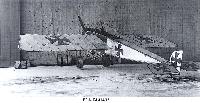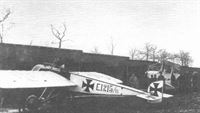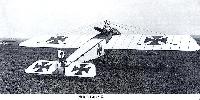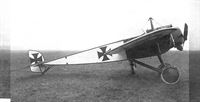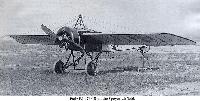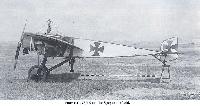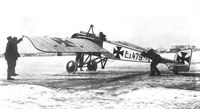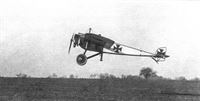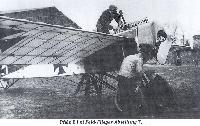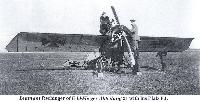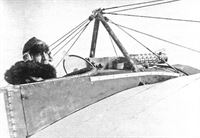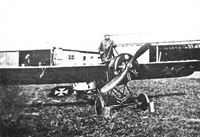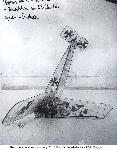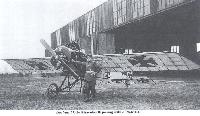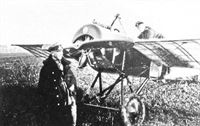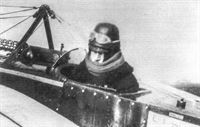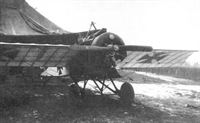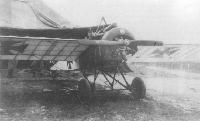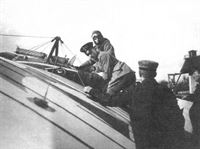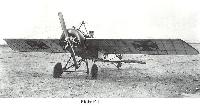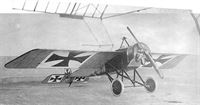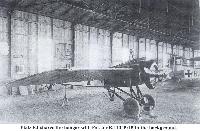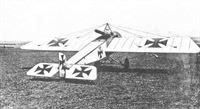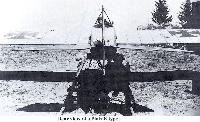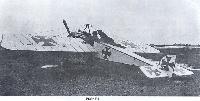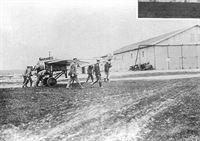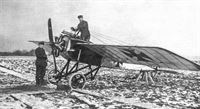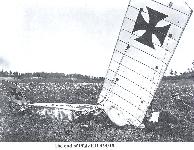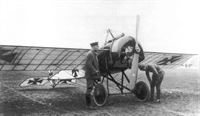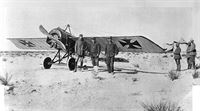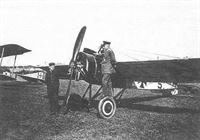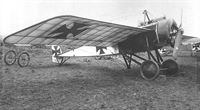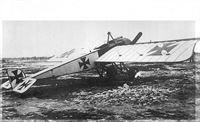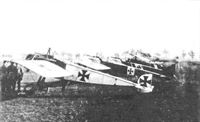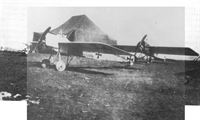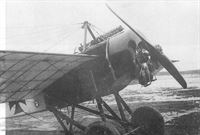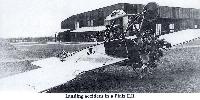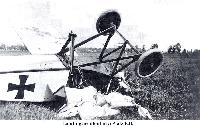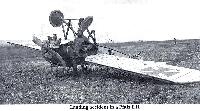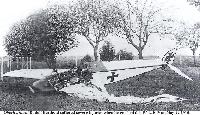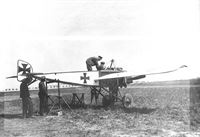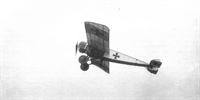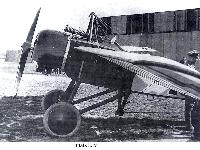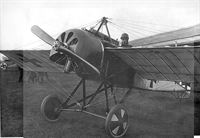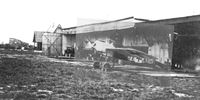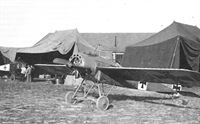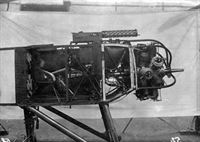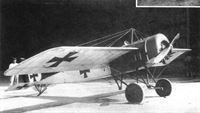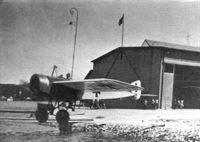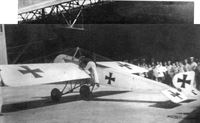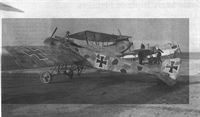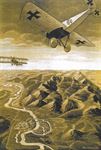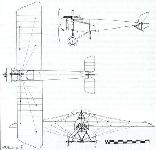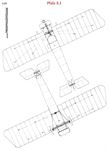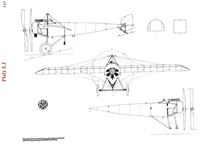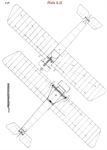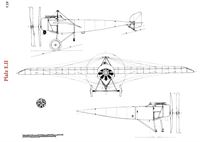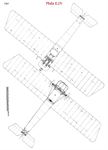
Описание
Страна: Германия
Год: 1915
Истребитель
Варианты
- Morane-Saulnier - G/H - 1912 - Франция
- Morane-Saulnier - hydro-monoplane - 1913 - Франция
- Morane-Saulnier - M - 1914 - Франция
- Pfalz - E.I/E.II/E.IV/E.VI - 1915 - Германия
- Pfalz - E.V - 1916 - Германия
- Thulin - K - 1916 - Швеция
- В.Кондратьев Самолеты первой мировой войны
- O.Thetford, P.Gray German Aircraft of the First World War (Putnam)
- W.Green, G.Swanborough The Complete Book of Fighters
- J.Herris Pfalz Aircraft of WWI (A Centennial Perspective on Great War Airplanes 5)
- M.Dusing German Aviation Industry in WWI. Volume 2 (A Centennial Perspective on Great War Airplanes 85)
- E.Hauke, W.Schroeder, B.Totschinger Die Flugzeuge der k.u.k. Luftfahrtruppe und Seeflieger 1914-1918
-
В.Кондратьев - Самолеты первой мировой войны
"Пфальц" E.I с пулеметом LMG 08 в стандартной для этого типа черно-белой "антикамуфляжной" окраске.
-
D.Mechin - Oriental Adventures of the French Air force 1914-1918 /Aeronaut/
Profile of a Pfalz E.II of the German park of Hudova. Inferior to the Fokker Eindecker which is contemporary to it, it is one of these second zone aircraft that Germans as well as French willingly sent to the Orient Front.
-
J.Herris - Pfalz Aircraft of WWI /Centennial Perspective/ (5)
Pfalz E.IV 647/15 wears the usual factory finish of white doped linen with black borders, and black struts, pylon and metal areas. The wheel covers were painted half white/half black.
-
J.Herris - Pfalz Aircraft of WWI /Centennial Perspective/ (5)
Pfalz E.IV #719 wears the usual factory finish of white doped linen with black borders, and black struts, pylon and metal areas. The wheel covers also had iron cross markings.
-
J.Herris - Pfalz Aircraft of WWI /Centennial Perspective/ (5)
The talented Bavarian artist-pilot Lt. Ferdinand 'Fritz' Grunzweig of Feldflieger Abteilung 9b considerably altered the appearance of his personal Pfalz E.IV. The cowling was decorated with detailed eyes in a manner that he would repeat on his later Fokker D.II machines; in addition the cowling was perforated with breathing holes for better cooling. The bright white finish of the monoplane was toned down by the application of a mottled finish to the upper surfaces of the wings and top and sides of the fuselage. The colors of this field-applied camouflage are unknown, and those illustrated are an arbitrary choice. The only available photos of this aircraft do not clarify if the rudder was given a similar treatment, so it is illustrated as 'white'.
-
J.Herris - Pfalz Aircraft of WWI /Centennial Perspective/ (5)
A Pfalz E.I on the Speyer airfield armed with a single Spandau LMG 08 machine gun. All Pfalz monoplanes were decorated in the typical Morane-Saulnier ornamental trim with fuselage, flying surfaces and rib tapes outlined in black. The coat of arms appears to be that of Speyer. The rudder shape was significantly different than Fokker rudders.
-
O.Thetford, P.Gray - German Aircraft of the First World War /Putnam/
Pfalz E.I (serial 173/15)
-
Сайт - Pilots-and-planes /WWW/
Pfalz E.I 213/15 was used as a trainer.
-
Сайт - Pilots-and-planes /WWW/
Pfalz E.I 213/15 was used as a trainer. The designation and serial number are just above the rudder cross.
-
J.Herris - Pfalz Aircraft of WWI /Centennial Perspective/ (5)
Pfalz E.I 215/15 at Feldflieger-Abteilung 19 on the Eastern Front. Many Pfalz E-types were relegated to the Eastern Front where they could be useful in that less demanding combat environment.
-
J.Herris - Pfalz Aircraft of WWI /Centennial Perspective/ (5)
A Fokker E.II (foreground) with Pfalz E.I 215/15 and a Pfalz E.II in the background provides an opportunity to compare the fighters. Allied airmen rarely, if ever, distinguished the Pfalz E-types from the Fokker E-types; all were identified as 'Fokkers'. The rudders were different shapes, but the most noticable difference between the types is the finish; the Fokker is plain linen and metal, whereas the Pfalz aircraft are white with black trim, black cowlings and black forward fuselages. The Pfalz E-types also have crosses on their elevators, while the Fokkers do not. This is the airfield of Feldflieger-Abteilung 19 on the Eastern Front, where many of the Pfalz E-types were assigned. All these differences went unnoticed by Allied aircrew in the heat of combat! Death notices in German newspapers of the time were bordered in black, so the black borders of the Pfalz E-types resulted in some gallows humor in the German air service. After a series of structural failures, all Pfalz E-types were removed from the front. Unlike Fokker, the Pfalz company was known for good workmanship, so these failures may have been due to the light structure of the pre-war Morane-Saulnier on which the Pfalz E-types were based, which was not stressed for the high-G maneuvers of air combat.
Другие самолёты на фотографии: Fokker E.I / E.II / E.III / M.14 - Германия - 1914
-
J.Herris - Pfalz Aircraft of WWI /Centennial Perspective/ (5)
Pfalz E.I (possibly 215/15) at Feldflieger-Abteilung 19, Flugplatz Porcher, thought to be December 1915. The 7-cylinder Oberursel U.O is clearly visible.
-
Сайт - Pilots-and-planes /WWW/
Pfalz E.I 216/15
-
J.Herris - Pfalz Aircraft of WWI /Centennial Perspective/ (5)
Пфальц E I зачастую путают с Моран-Солнье Н и даже с Фоккером E III.
Pfalz E.I 458/15 had a small, propeller-driven fuel pump mounted on the wing-warping structure below the fuselage. -
Сайт - Pilots-and-planes /WWW/
Pfalz E.I 473/15 in new condition on the Speyer field.
-
Сайт - Pilots-and-planes /WWW/
Pfalz E.I 473/15 in new condition on the Speyer field.
-
Сайт - Pilots-and-planes /WWW/
Pfalz E.I 473/15 on the Speyer field.
-
J.Herris - Pfalz Aircraft of WWI /Centennial Perspective/ (5)
Pfalz E.I 479/15 at Vilna on the Eastern Front. Many Pfalz monoplanes were assigned to the Eastern Front, where the air war was much less intense than the Western Front and the Pfalz monoplanes could be useful.
-
J.Herris - Pfalz Aircraft of WWI /Centennial Perspective/ (5)
The Pfalz Eindeckers were originally license-built pre-war Morane-Saulnier Type H monoplanes. Pfalz converted them to fighters when Fokker's synchronizer because available. Based on a pre-war design, the strength, performance, and flying qualities of the Pfalz Eindecker fighters were mediocre and they were eventually removed from the front and relegated to training use due to structural problems. The pre-war MS airframe was simply not designed to withstand high-G, maneuvering combat.
-
Сайт - Pilots-and-planes /WWW/
Pfalz E.I of Feld-Flieger Abteilung 7.
-
J.Herris - Pfalz Aircraft of WWI /Centennial Perspective/ (5)
Pfalz E.I with Lt. Czermack in the cockpit.
-
Сайт - Pilots-and-planes /WWW/
Leutnant Fischinger of Feld-Flieger Abteilung 21 with his Pfalz E.I.
-
J.Herris - Pfalz Aircraft of WWI /Centennial Perspective/ (5)
Oblt. Fischinger in a Pfalz E.I of Flieger-Abteilung 21.
-
J.Herris - Pfalz Aircraft of WWI /Centennial Perspective/ (5)
Unteroffizier Max Holtzem in the Pfalz E.I he used for aerobatic demonstrations at the factory. The underside is painted black with white insignia.
-
Сайт - Pilots-and-planes /WWW/
Unteroffizier Max Holtzem, who for a while performed military acceptance flights.
-
Сайт - Pilots-and-planes /WWW/
Holtzem's crash on February 23, 1916 at Schleissheim in a Pfalz E-type.
-
Сайт - Pilots-and-planes /WWW/
Lt. Otto Kissenberth with a Pfalz E.I at KEK (Kampfeinsitzer Kommando) Ensisheim. The E.I shows the iron crosses beneath the wings and tailplane. The wing structure shows through the fabric, and the Pfalz logo is on the center of the engine cowling. Kissenberth first became a fighter pilot at KEK Ensisheim and went on to score 20 confirmed victories and win the Pour le Merits before crashing a captured Sopwith Camel. His last victory was in the captured Camel. His injuries kept him out of further combat. Kissenberth was one of a number of aces who wore glasses.
-
J.Herris - Pfalz Aircraft of WWI /Centennial Perspective/ (5)
Oblt. Krug in front of a Pfalz E.I.
-
J.Herris - Pfalz Aircraft of WWI /Centennial Perspective/ (5)
Pfalz E.I 205/15 with Lt. Loessl in the cockpit.
-
J.Herris - Pfalz Aircraft of WWI /Centennial Perspective/ (5)
Pfalz E.I of Feldflieger-Abteilung 21 flown by Lt.d.R. Ernst von Lossl. Lossl was wounded on 23 May, 1917 while flying with Jasta 18; he died the next day.
-
K.Delve - World War One in the Air /Crowood/
The Pfalz E.I had its origins as an unarmed reconnaissance aircraft but with the advent of the Fokker synchronization gear in 1915 it appeared, like the Fokker E.I (and E.III) with a forward-firing Spandau.
-
J.Herris - Pfalz Aircraft of WWI /Centennial Perspective/ (5)
Lt. Mohring in his Pfalz E.I over a winter landscape.
-
J.Herris - Pfalz Aircraft of WWI /Centennial Perspective/ (5)
Lt. Otto Parschau in a Pfalz E.I. A flare pistol is attached to the outside of the cockpit. Parschau was awarded the Pour le Merits on 10 July 1916 after 8 confirmed victories, a high number at that time.
-
Сайт - Pilots-and-planes /WWW/
The Pfalz E I was broadly based on the Morane-Saulnier Type H and began to arrive at the Front from late October 1915.
-
J.Herris - Pfalz Aircraft of WWI /Centennial Perspective/ (5)
Unlike the standard light factory finish, this Pfalz E.I appears to be in a dark finish.
-
Сайт - Pilots-and-planes /WWW/
Pfalz E.I shares the hangar with Fokker B.I 1045/15 in the background.
-
J.Herris - Pfalz Aircraft of WWI /Centennial Perspective/ (5)
Pfalz E.I; the serial is obscured by the wing.
-
J.Herris - Pfalz Aircraft of WWI /Centennial Perspective/ (5)
Pfalz E.I; unlike Fokker monoplanes, Pfalz monoplanes had iron cross insignia on top and bottom of the elevators.
-
Сайт - Pilots-and-planes /WWW/
Rear view of a Pfalz E-type.
-
Сайт - Pilots-and-planes /WWW/
Pfalz E.I.
-
J.Herris - Pfalz Aircraft of WWI /Centennial Perspective/ (5)
A Pfalz Eindecker being repositioned on the airfield.
-
J.Herris - Pfalz Aircraft of WWI /Centennial Perspective/ (5)
Ammunition being loaded into a Pfalz E.I.
-
J.Herris - Pfalz Aircraft of WWI /Centennial Perspective/ (5)
Pfalz E.II 226/15 in the foreground and a Pfalz E.I in the background; the triple wing cables of the E.II differentiate it from the E.I, which has only two cables per wing. From the front the 9-cylinder engine of the E.II differentiates if from the E.I with its 7-cylinder engine. E.226/15 was the first aircraft of the first E.II production batch ordered in Sept. 1915.
-
J.Herris - Pfalz Aircraft of WWI /Centennial Perspective/ (5)
Lt. Walter von Bulow in his Pfalz E.II (278/15?), probably with Feldflieger-Abteilung 22 where he achieved the first of his 28 victories. He was awarded the Pour le Merite after 21 victories.
-
J.Herris - Pfalz Aircraft of WWI /Centennial Perspective/ (5)
Pfalz E.II 454/15 is walked out for take-off. The light cowling was painted at unit level; it was black from the factory.
The Pfalz and Fokker Eindecker monoplane fighters were the world's first truly successful fighters and had a profound effect on the development of air power. -
J.Herris - Pfalz Aircraft of WWI /Centennial Perspective/ (5)
Rear quarter view of Pfalz E.II 454/15 showing the iron cross insignia Pfalz added to the elevators and the three sets of flying wires needed for the longer wing.
-
J.Herris - Pfalz Aircraft of WWI /Centennial Perspective/ (5)
Another view of Pfalz E.II 454/15.
-
Сайт - Pilots-and-planes /WWW/
The end of Pfalz E.II 454/15.
-
J.Herris - Pfalz Aircraft of WWI /Centennial Perspective/ (5)
Pfalz E.II 649/15. The Pfalz logo is on the upper center of the engine cowling, like the Morane-Saulniers from which it was derived.
-
J.Herris - Development of German Warplanes in WWI /Centennial Perspective/ (1)
Leutnant Hans Henkel with FA (Flieger Abteilung) 300 "Pascha" on the Palestinian Front poses with his ground crew and Pfalz E.II. This was the only Pfalz E-type to serve in Palestine. Power was the 100 hp Oberursel U.l.
-
J.Herris - Pfalz Aircraft of WWI /Centennial Perspective/ (5)
Unteroffizier Max Holtzem prepares to take off in a Pfalz E.II.
-
J.Herris - Pfalz Aircraft of WWI /Centennial Perspective/ (5)
Pfalz E.II with tactical number '5' on the rear fuselage.
-
J.Herris - Pfalz Aircraft of WWI /Centennial Perspective/ (5)
A Pfalz E.II of Feld-Flieger Abteilung 64 at the end of the Eindecker era in October 1916.
-
M.Dusing - German & Austro-Hungarian Aero Engines of WWI. Vol.3 /Centennial Perspective/ (66)
Pfalz E II with 100 hp Oberursel U I rotary. The engine was also used in the Fokker E III. The iron cross insignia under the elevators are visible.
-
J.Herris - Pfalz Aircraft of WWI /Centennial Perspective/ (5)
The Pfalz E.II was powered by a nine-cylinder 100 hp Oberursel U.I rotary engine.
-
J.Herris - Pfalz Aircraft of WWI /Centennial Perspective/ (5)
Pfalz E.II aligned for adjusting the wing rigging. The large angle of incidence made the Pfalz monoplanes especially sensitive to asymmetric rigging
-
J.Herris - Pfalz Aircraft of WWI /Centennial Perspective/ (5)
Pfalz E.II at the factory. The white rectangle on the cowling is the manufacturer's nameplate.
-
J.Herris - Pfalz Aircraft of WWI /Centennial Perspective/ (5)
Pfalz E.II. The Pfalz E-types were withdrawn from service following a number of in-flight structural failures. The Pfalz monoplanes were based on the pre-war Morane-Saulnier Type H, a lightly-build aircraft that was not designed for high "G" combat maneuvering.
-
Сайт - Pilots-and-planes /WWW/
Pfalz E.II
-
J.Herris - Pfalz Aircraft of WWI /Centennial Perspective/ (5)
A Pfalz E.II heads a lineup including two Fokker E.IIIs, a Pfalz A.II, and an Ago C.I (or C.II) of Feld-Flieger Abteilung 9b.
Другие самолёты на фотографии: AGO C.I / C.II - Германия - 1915Fokker E.I / E.II / E.III / M.14 - Германия - 1914Pfalz A.I/E.III - Германия - 1914
-
J.Herris - Otto, AGO and BFW Aircraft of WWI /Centennial Perspective/ (37)
Ago C.I aircraft and Pfalz Eindeckers in a wooden hangar.
Другие самолёты на фотографии: AGO C.I / C.II - Германия - 1915
-
J.Herris, J.Scott - Fokker Aircraft of WWI. Vol.2: Eindeckers /Centennial Perspective/ (52)
A Fokker M.14V (E.III) of Kampf Einsitzer Kommando Vaus parked on a German Army air field near the front. The aircraft in the background is a Pfalz E.II. The Fokker carried the serial 635/15.
In the company of a Pfalz E.II and another Fokker, E.III 635/15 now appears to be sporting a Heine prop. (Peter M. Grosz collection/STDB)Другие самолёты на фотографии: Fokker E.I / E.II / E.III / M.14 - Германия - 1914
-
J.Herris, J.Scott - Fokker Aircraft of WWI. Vol.2: Eindeckers /Centennial Perspective/ (52)
A Fokker E.II/early E.III of KEK Avillers is seen with a Pfalz E.II (at left) and Fokker E.III 331/16. In the bright sunlight, the opaque nature of the Fokkers' fabric is contrasted with the translucency of the Pfalz. (Peter M. Grosz collection/STDB)
Другие самолёты на фотографии: Fokker E.I / E.II / E.III / M.14 - Германия - 1914
-
J.Herris, J.Scott - Fokker Aircraft of WWI. Vol.2: Eindeckers /Centennial Perspective/ (52)
Ernst Udet stands with arms akimbo in front of Fok. E.III 404/15. It had a thin 2-tone band around the tail and a rudder with a small Eisernes Kreuz. Fok E.III 105/15 is in the background along with a pair of Pfalz Eindeckers. (Aviation Heritage Trust)
Другие самолёты на фотографии: Fokker E.I / E.II / E.III / M.14 - Германия - 1914
-
J.Herris - Pfalz Aircraft of WWI /Centennial Perspective/ (5)
Nose of a Pfalz E.II.
-
Сайт - Pilots-and-planes /WWW/
Landing accident in a Pfalz E.II
-
Сайт - Pilots-and-planes /WWW/
Landing accident in a Pfalz E.II
-
Сайт - Pilots-and-planes /WWW/
Landing accident in a Pfalz E.II
-
Сайт - Pilots-and-planes /WWW/
Landing accident in a Pfalz E.II
-
Сайт - Pilots-and-planes /WWW/
Landing accident in a Pfalz E.II
-
Сайт - Pilots-and-planes /WWW/
Landing accident in a Pfalz E.II
-
Сайт - Pilots-and-planes /WWW/
Pfalz E.IV 647/15, an aircraft of the first production batch.
-
Сайт - Pilots-and-planes /WWW/
Oblt. Rudolf Berthold crashed in Pfalz E.IV 803/15 at Chateau Vaux aerodrome on 25 April (22 May ???), 1916. The serious injuries Berthold experienced in this crash were the first of many wounds and injuries that finally forced his removal from the front, but not before scoring 44 confirmed victories and being awarded the Pour le Merite.
-
J.Herris - Pfalz Aircraft of WWI /Centennial Perspective/ (5)
Adjusting the machine guns on Pfalz E.IV 812/15.
-
J.Herris - Pfalz Aircraft of WWI /Centennial Perspective/ (5)
Two views of the Pfalz E.IV of Lt. Friedrich Grunzweig of Feld-Flieger Abteilung 9b, 1916; the aircraft has suffered an accident and is being recovered by a ground crew. Grunzweig was an artist and personally painted his aircraft with the eyes on the cowling and on the camouflage on the sides and upper surfaces of the aircraft. The cowling was perforated, most likely to provide additional air cooling to the two-row rotary engine.
-
J.Herris - Pfalz Aircraft of WWI /Centennial Perspective/ (5)
Lt. Otto Kissenberth takes off in a Pfalz E.IV trailing a cloud of exhaust smoke from its two-row Oberursel U.III rotary engine. Kissenberth scored 20 victories and was awarded the Pour le Merite on 30 June 1918 as an Oberleutnant.
-
Сайт - Pilots-and-planes /WWW/
Leutnant Ernst Udet crashed a Pfalz E.IV when he was attached to the Kampf-Einsitzer-Kommando Habsheim.
-
J.Herris - Pfalz Aircraft of WWI /Centennial Perspective/ (5)
A Pfalz E.IV of Kampfeinsitzer-Kommando (KEK) Ensisheim takes off.
-
Сайт - Pilots-and-planes /WWW/
Pfalz E.IV
-
M.Dusing - German Aviation Industry in WWI. Volume 2 /Centennial Perspective/ (85)
No serial number is visible on this unarmed Pfalz E.IV.
-
J.Herris - Pfalz Aircraft of WWI /Centennial Perspective/ (5)
Pfalz E.IV powered by an Oberursel UIII engine with 14 cylinder developing 150 hp. The engine was also used in the Fokker E IV.
A new Pfalz E.IV awaiting armament installation. Restricted to a small series, the E IV saw little frontline use owing to its shortcomings. -
J.Herris - Pfalz Aircraft of WWI /Centennial Perspective/ (5)
From this head-on view it is apparent that this Pfalz E.IV has its iron cross insignia on the wings painted over white fields. This is unusual because the Pfalz monoplanes were so white overall that white fields seem redundant.
-
J.Herris - Development of German Warplanes in WWI /Centennial Perspective/ (1)
The Pfalz E.IV is distinctive due to its twin-row 160 hp Oberursel U.III rotary engine, which required an additional front bearing support, and twin Spandau LMG 08 machine guns. The E.IV had larger wings than earlier Pfalz E-types to handle the additional weight, and a longer tail to balance the heavier engine and two guns. Pfalz was fond of the German national insignia and applied it to upper and lower surfaces of the tailplane in addition to its standard locations.The E.IV here even has the iron cross on the wheel covers.
-
Журнал - Flight за 1918 г.
Three views of a German Pfalz monoplane, from a recent German publication. This machine is, so far as one is able to ascertain, an exact copy of the pre-war French Morane. The machine has not, we believe, been built for several years.
-
J.Herris, J.Scott - Fokker Aircraft of WWI. Vol.2: Eindeckers /Centennial Perspective/ (52)
A Fokker E.III and a Pfalz E.IV of FFA 62/KEK 3 share one of the hangars on the airfield at Douai. The gable and porch of "das Immelmannhaus" (the pilots' starter hut) can be seen beyond. (Rainer Absmeier)
Другие самолёты на фотографии: Fokker E.I / E.II / E.III / M.14 - Германия - 1914
-
J.Herris, J.Scott - Fokker Aircraft of WWI. Vol.2: Eindeckers /Centennial Perspective/ (52)
Fokker E.IV 186/16 (w/n 575) appears to have been given a coat of a solid mid-tone color, notably covering the nose and tail of the aircraft. Like 183/16, it has an additional access panel in the decking above the guns. A Pfalz E.IV is undergoing maintenance in the background. (Reinhard Kastner)
Другие самолёты на фотографии: Fokker E.IV / M.15 - Германия - 1915
-
J.Herris - Development of German Warplanes in WWI /Centennial Perspective/ (1)
The Pfalz E.IV is distinctive due to its twin-row 160 hp Oberursel U.III rotary engine, which required an additional front bearing support, and twin Spandau LMG 08 machine guns.
-
J.Herris - Pfalz Aircraft of WWI /Centennial Perspective/ (5)
This Pfalz E.VI, purchased by the Austro-Hungarian Navy in July 1916, shows the two-wire bracing compared to the three-wire bracing of the E.II from which it was derived. The fuselage may have been lengthened to improve handling, but by this time the basic design was obsolete.
-
E.Hauke, W.Schroeder, B.Totschinger - Die Flugzeuge der k.u.k. Luftfahrtruppe und Seeflieger 1914-1918
This Pfalz E.VI, A.10, purchased by the Austro-Hungarian Navy in July 1916, shows the different rudder shape and two-wire bracing. Pfalz painted national insignia on top and bottom of the elevators for these aircraft as well. S. Catharina, August 1916
-
J.Herris - Pfalz Aircraft of WWI /Centennial Perspective/ (5)
Three rare aircraft are captured in this photo. A Pfalz E.VI in the foreground was hand painted with lozenge patterns to test a new camouflage system; it retains the national insignia on the elevators. The Pfalz E.V Typenprufung machine in the background dates this photo to July 1916. Directly behind the E.VI is Albatros C.IV C.850/16 as can be determined by its distinctive wing and interplane struts.
Другие самолёты на фотографии: Albatros C.IV - Германия - 1916Pfalz E.V - Германия - 1916
-
J.Herris - Pfalz Aircraft of WWI /Centennial Perspective/ (5)
This interesting photo was taken of the camouflaged Pfalz E.VI inflight, perhaps to help evaluate the effectiveness of its camouflage. The pattern was hand painted, which required too much labor to be practical. Printed fabric in lozenge pattern was later developed and widely used; it would be interesting to know if the printed fabric was related in any way to this experiment.
-
J.Herris - Pfalz Aircraft of WWI /Centennial Perspective/ (5)
Pfalz poster showing a Pfalz E.II.
-
J.Herris - Pfalz Aircraft of WWI /Centennial Perspective/ (5)
Poster from the Pfalz company.
-
J.Herris - Pfalz Aircraft of WWI /Centennial Perspective/ (5)
This poster advertising the Pfalz E.IV illustrates the color scheme for the Pfalz monoplane fighters. Pfalz obtained a manufacturing license for several Morane-Saulnier monoplanes before the war and used essentially the same color scheme; gloss black cowling and other metal parts, wheel covers, and outlines of the flying surfaces. Iron cross national markings were applied to both sides of the wings and tailplane, the fuselage, and the rudder. The fabric was very white and reflected sunlight.The Pfalz logo on the nose replaced the Morane-Saulnier logo in the same location.The Pfalz posters were created by noted artist Max Schammler of Berlin.
-
W.Green, G.Swanborough - The Complete Book of Fighters
The Pfalz E I was broadly based on the Morane-Saulnier Type H and began to arrive at the Front from late October 1915.
-
В.Кондратьев - Самолеты первой мировой войны
"Пфальц" E.I
В.Кондратьев Самолеты первой мировой войны
"ПФАЛЬЦ" E.I/E.II/E.III/E.IV / PFALZ E.I/E.II/E.III/E.IV
Основанная в 1913 году южногерманская фирма "Пфальц Флюгцойгверк" начала свою деятельность с лицензионного копирования французских двухместных аэропланов "Моран-Солнье" типов H (среднеплан) и L (моноплан-парасоль) с 80-сильными ротативными моторами "Оберурсель" U.O. Первый из них получил в Германии обозначение "Пфальц" E.I, а второй - "Пфальц" A.I. Те же машины, оснащенные 100-сильными двигателями "Оберурсель" U.I, назывались, соответственно, "Пфальц" E.II и А.II. Выпуск этих машин продолжался в 1914 и 1915 годах. На раннем этапе Мировой войны они применялись для разведки и аэрофотосъемки.
Когда летом 1915-го на фирме "Фоккер" был создан первый работоспособный пулеметный синхронизатор, инженеры завода "Пфальц" решили превратить E.I в истребитель. Машину оснастили синхронным пулеметом LMG 08, установленным над капотом. В остальном самолет практически ничем не отличался от своего французского "предка". Всего в течение лета и осени 1915 г. построено порядка 60 вооруженных E.I и Е.II, которые, в основном, поступали в баварские авиаэскадрильи и воевали на западном фронте.
Обозначение E.III носил оснащенный синхронным пулеметом парасоль A.II. Этот аппарат также строился малой серией и поступал в войска.
Завершающим в "линейке" истребителей-монопланов фирмы "Пфальц" был
E.IV, оснащенный двухрядным 14-цилиндровым ротативным мотором "Оберурсель" Ur.III мощностью 160 л.с. Самолет отличался увеличенными размерами и массой, усиленной конструкцией планера, а также - более мощным вооружением, состоящим из двух синхронных пулеметов LMG 08. По своим летным характеристикам E.IV превосходил более ранние модификации "Пфальца", но его "ахиллесовой пятой" стала низкая надежность двигателя. Серийный выпуск этой машины составил всего 24 экземпляра.
ЛЕТНО-ТЕХНИЧЕСКИЕ ХАРАКТЕРИСТИКИ
E.I E.IV
Размах, м 9,26 10,2
Длина, м 6,3 6,6
Площадь крыла, м2 14,0 16,0
Сухой вес, кг 345 471
Взлетный вес, кг 535 695
Скорость макс, км/ч 140 160
Время набора высоты
2000 м., мин. - 8,5
Потолок, м 3900 4200
Описание:











